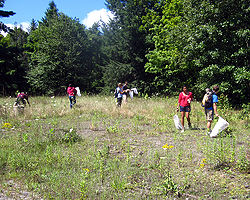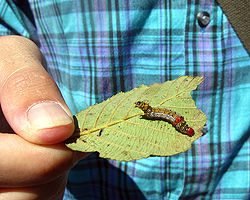Difference between revisions of "General Entomology"
| (10 intermediate revisions by the same user not shown) | |||
| Line 3: | Line 3: | ||
[[Image:Caterpillar.jpg|250px|thumb|right|]]<br> | [[Image:Caterpillar.jpg|250px|thumb|right|]]<br> | ||
<span style="font-size: x-large">EEB 4250 - General Entomology</span><br><br> | <span style="font-size: x-large">EEB 4250 - General Entomology</span><br><br> | ||
| − | <span style="font-size: large">Fall | + | <span style="font-size: large">Fall 2014</span> <br><br> |
<span style="font-size: small">'''Day/Time:''' Tuesday+Thursday 12:30-3:30<br> | <span style="font-size: small">'''Day/Time:''' Tuesday+Thursday 12:30-3:30<br> | ||
'''Place:''' Storrs campus, Torrey Life Sciences Room 313<br> | '''Place:''' Storrs campus, Torrey Life Sciences Room 313<br> | ||
| Line 19: | Line 19: | ||
*Gullan, P. J. and P. S. Cranston. 2010. The Insects: An Outline of Entomology. Fourth Ed. Blackwell Science, Oxford, England. <br> | *Gullan, P. J. and P. S. Cranston. 2010. The Insects: An Outline of Entomology. Fourth Ed. Blackwell Science, Oxford, England. <br> | ||
<br> | <br> | ||
| + | {{Under Construction}} | ||
==Introduction== | ==Introduction== | ||
The lectures provide a broad introduction to insect diversity, phylogeny, structure and function, behavior, ecology, and conservation. The laboratory stresses sight identification and natural history of 120 common insect families. The collection requirement connects the lecture and laboratory by linking lecture topics, and especially insect behavior and ecology, to Connecticut’s extraordinary insect fauna. | The lectures provide a broad introduction to insect diversity, phylogeny, structure and function, behavior, ecology, and conservation. The laboratory stresses sight identification and natural history of 120 common insect families. The collection requirement connects the lecture and laboratory by linking lecture topics, and especially insect behavior and ecology, to Connecticut’s extraordinary insect fauna. | ||
| Line 32: | Line 33: | ||
== Syllabus and Course Materials== | == Syllabus and Course Materials== | ||
| + | <!-- | ||
'''Full Syllabus:''' {{pdf|http://hydrodictyon.eeb.uconn.edu/courses/entomology/restricted/Syllabus_2012%2028%20August.docx}}Syllabus 2012<br> | '''Full Syllabus:''' {{pdf|http://hydrodictyon.eeb.uconn.edu/courses/entomology/restricted/Syllabus_2012%2028%20August.docx}}Syllabus 2012<br> | ||
| Line 49: | Line 51: | ||
:{{pdf|http://hydrodictyon.eeb.uconn.edu/courses/entomology/restricted/live%20insect%20project.docx}}Live Insect Project | :{{pdf|http://hydrodictyon.eeb.uconn.edu/courses/entomology/restricted/live%20insect%20project.docx}}Live Insect Project | ||
<br> | <br> | ||
| + | '''Collection Guidelines'''<br> | ||
| + | {{pdf|http://hydrodictyon.eeb.uconn.edu/courses/entomology/restricted/Collection%20Grading%202012.doc}}Collection Grading 2012.doc<br> | ||
| + | <br> | ||
| + | '''Collection Tips'''<br> | ||
| + | 1) Ensure your name is clearly written on all boxes.<br> | ||
| + | 2) Please keep your vials in an easy-to-access container.<br> | ||
| + | 3) You must hand in a printed spreadsheet (found on the course website) along with your collection. Your name must be on it. The written families should be in the same order as the specimens in your boxes.<br> | ||
| + | 4) Don't forget about the ecological labels. Think about them carefully, this is an easy way to make mistakes if you rush.<br> | ||
| + | 5) Put the labels in the right order on the pin. Locality label on top, then species label (if needed), then ecological label (if needed), then family label (if it's the first in the row). Labels should be in line with the specimen and take up as little space as possible and still be legible. They should all be facing the same direction.<br> | ||
| + | 6) Organization of orders/families within the box is unimportant, as long as it is clear. Try to condense to as few boxes as possible.<br> | ||
| + | 7) Remember that the curation guidelines are to ensure that your specimens are "museum ready" - they might be your longest legacy on earth. Think about how beautifully well organized Dave's collection is upstairs, and the main collection next door. Look at your specimens and ask if they are ready to be seamlessly integrated into a museum collection.<br> | ||
| + | 8) Don't fret too much about a bad specimen (missing legs, etc) if it's the only one you have. Damaged specimens are still valuable if properly labeled.<br> | ||
| + | 9) Moderate trading is encouraged.<br> | ||
| + | 10) Some specimens will be taken and added to the main collection (you should take this as a compliment, I had several of my specimens taken). If you have a favorite specimen you are particularly attached to, like something you raised as a pet, leave a note on your spreadsheet. <br> | ||
{| border="1" cellpadding="1" | {| border="1" cellpadding="1" | ||
!width="100"|Date | !width="100"|Date | ||
| Line 111: | Line 127: | ||
| Nov 27 || Entomophagous Insects<br>{{pdf|http://hydrodictyon.eeb.uconn.edu/courses/entomology/restricted/Entomophagous_Insects_2012_updated.pdf}}Entomophagous Insects || || Hymenoptera I<br>{{pdf|http://hydrodictyon.eeb.uconn.edu/courses/entomology/restricted/lab%2024_hymenoptera%201_BZ_2012.pdf}}Lab 24 || | | Nov 27 || Entomophagous Insects<br>{{pdf|http://hydrodictyon.eeb.uconn.edu/courses/entomology/restricted/Entomophagous_Insects_2012_updated.pdf}}Entomophagous Insects || || Hymenoptera I<br>{{pdf|http://hydrodictyon.eeb.uconn.edu/courses/entomology/restricted/lab%2024_hymenoptera%201_BZ_2012.pdf}}Lab 24 || | ||
|- | |- | ||
| − | | Nov 29 || | + | | Nov 29 || Medical Entomology<br>{{pdf|http://hydrodictyon.eeb.uconn.edu/courses/entomology/restricted/Medical%20Entomology%202012.pdf}}Medical Entomology ||'''Quiz 7''': Mecopteroidea || Hymenoptera II ||G+C Chapter 15<br>[http://caterpillar-eyespots.blogspot.com Caterpillar Eyespots]<br>{{pdf|http://hydrodictyon.eeb.uconn.edu/courses/entomology/restricted/the%20ant%20and%20the%20acacia%20tree.PDF}}The Ant and the Acacia Tree<br>{{pdf|http://hydrodictyon.eeb.uconn.edu/courses/entomology/restricted/why%20did%20God%20make%20flies.PDF}}Why Did God Make Flies? |
|- | |- | ||
| − | | Dec 4 || Pest | + | | Dec 4 || Medical Entomology<br>{{pdf|http://hydrodictyon.eeb.uconn.edu/courses/entomology/restricted/Medical%20Entomology%202012_part2.ppt}} Medical Entomology<br>Insect Ecology and Pest Management<br>{{pdf|http://hydrodictyon.eeb.uconn.edu/courses/entomology/restricted/Insect%20Ecology%20and%20Pest%20Management%202012.pdf}}Insect Ecology and Pest Management || || Open lab || G+C Chapter 16 |
|- | |- | ||
| − | | Dec 6 || Insect conservation || '''LAB PRACTICUM''' || Open lab || | + | | Dec 6 || Insect Ecology{{pdf|http://hydrodictyon.eeb.uconn.edu/courses/entomology/restricted/Insect%20Ecology%20and%20Pest%20Management%202012%20Part%20II.pdf}}Insect Ecology and Pest Management 2012 Part II<br>Insect conservation<br>{{pdf|http://hydrodictyon.eeb.uconn.edu/courses/entomology/restricted/Insect%20Conservation%202012.pdf}}Insect conservation || '''LAB PRACTICUM''' || Open lab || |
|- | |- | ||
| − | | | + | | Dec 14 || ''' FINAL EXAM'''<br>10:30-12:30 || '''COLLECTION DUE'''<br>Midnight<br>(must absolutely be done before I come in Saturday morning)|| || |
| + | --> | ||
Revision as of 20:08, 5 August 2014
EEB 4250 - General Entomology
Fall 2014
Day/Time: Tuesday+Thursday 12:30-3:30
Place: Storrs campus, Torrey Life Sciences Room 313
Credits: 4
Instructor: David Wagner
- Life Sciences Rm 471
- 860-486-2139 and 860-942-1796 (cell)
- Office hours: 10 MWF and as available
- Life Sciences Rm 473
- 518-573-3091 (cell)
- Office hours: as available (email for appointment)
Textbook:
- Borror, DJ and RE White, 1970. Peterson Field Guide to Insects: America North of Mexico.
- Gullan, P. J. and P. S. Cranston. 2010. The Insects: An Outline of Entomology. Fourth Ed. Blackwell Science, Oxford, England.

|
This article is still under construction. Expect it to change frequently until this notice is removed. |
Introduction
The lectures provide a broad introduction to insect diversity, phylogeny, structure and function, behavior, ecology, and conservation. The laboratory stresses sight identification and natural history of 120 common insect families. The collection requirement connects the lecture and laboratory by linking lecture topics, and especially insect behavior and ecology, to Connecticut’s extraordinary insect fauna.
Course Procedures and Policies
Academic Integrity:
Plagiarism and cheating are violations of the student conduct code, and may be punished by failure in the course or, in severe cases, dismissal from the University. For more information, see Appendix A of the Student Conduct Code.
Disabilities:
If you have a disability for which you may be requesting an accommodation, you should contact a course instructor and the Center for Students with Disabilities (Wilbur Cross Building, Room 201) within the first two weeks of the semester.


